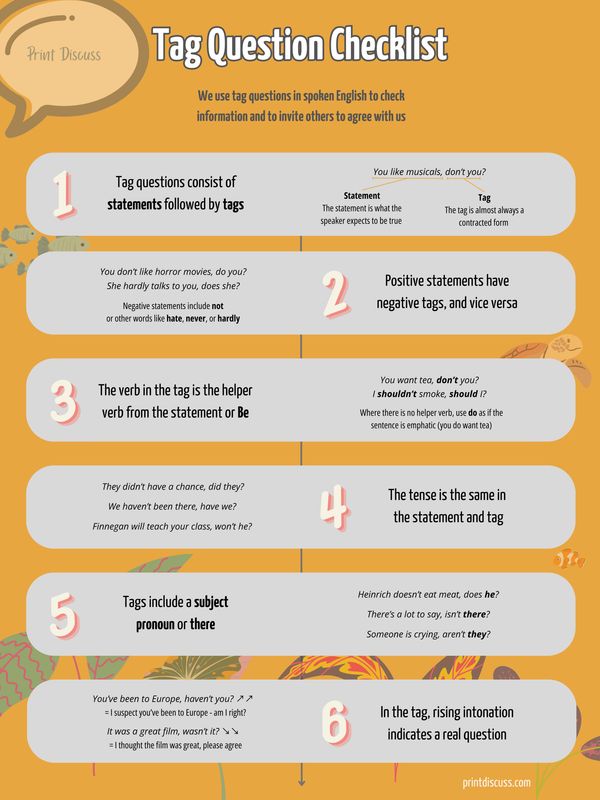What Students Need to Know to Ask and Answer Tag Questions
We use tag questions, like other questions, to get information. We also use them to invite another person to agree with us. They are used mostly in spoken English. There are a few things to keep track of, but students seem to get the hang of them quickly and enjoy using them.
When I’ve taught tag questions in the past, I’ve gone step-by-step through what students need to know and asked them to complete examples at each stage. The summary at the bottom of this post can help them to remember the various components when it comes time to put it all together.
If your students are already good at asking and answering tag questions, consider giving them some practice with these question sets: Tag Question Formation and Tag Question Practice.
Forming Tag Questions
The first thing to keep in mind with a tag question is that it’s a statement followed by a tag. A common mistake learners make is trying to ask a question in the first part of the sentence.
[statement] You like musicals, [tag] don’t you?
The statement, the first part, tends to be what the speaker expects to be true. In the above example, the speaker suspects or is checking that the listener likes musicals.
The tag, the second part, is almost always a contracted form. Non-contracted forms sound quite formal and dated.
Choosing the Pronoun in the Tag
Pronouns are always used in tags. When the statement has a subject pronoun, the same subject pronoun is used in the tag.
They are coming, aren’t they?
The statement may have some other kind of noun, in which case we need to pick the equivalent subject pronoun for the tag.
Heinrich doesn’t eat meat, does he?
Here are the tags for some trickier cases:
This/that/words ending with -thing (something, everything, etc.) → it
This is the end, isn’t it?
Everything went wrong, didn’t it?
These/those/words ending with -one or -body (someone, somebody, etc.) → they
These are finished, aren’t they?
Everyone thinks I’m wrong, don’t they?
There + be → there
There’s a lot to say, isn’t there?
Choosing the Verb in the Tag
In most tag questions, there is alternation between positive and negative. A positive statement is followed by a negative tag, and a negative statement is followed by a positive tag. A negative statement doesn’t only include not. Words like never and hardly make a statement negative, too.
You don’t like horror movies, do you?
He hates the outdoors, doesn’t he?
She hardly talks to you, does she?
Meanwhile, the tense should be the same in each part.
They didn’t have a chance, did they?
As is evident in the above example, the verb in the tag is the auxiliary (helper) verb from the statement part. In the next example, the helper verb is have.
We haven’t been there, have we?
For verbs that do not have a helper verb, use do (as if an emphatic sentence was made, eg. ‘You want tea’ can be thought of as ‘You do want tea’).
You want tea, don’t you?

In other cases, the helper verb is a modal verb.
Rangi can swim, can’t he?
It could be hot there, couldn’t it?
Finnegan will teach your class, won’t he?
They would like that, wouldn’t they?
I shouldn’t smoke, should I?
He must have finished, mustn’t he?
It’s rare to hear tag questions made with may or ought to. Mightn't is used sometimes in the UK.
Be and Have
Statements with be as the main verb are special in that be, the main verb, is repeated in the tag.
They are doctors, aren’t they?
And when I am is used, oddly, we always use aren’t I in the tag.
I’m up next, aren’t I?
Primarily in British English, when have is the main verb, like be, it is often used in the tag. In American English, it’s standard to hear do.
He has a car, hasn’t he? (UK)
He has a car, doesn’t he? (US)
Give students practice at forming tag questions with the prompts at Tag Question Formation.
Intonation When Asking a Tag Question
After students have the word order down, they’re ready to practice changing the tone of the tag. A rising tone in the tag means it’s a true question in the sense that the speaker wants information.
You’ve been to Europe, haven’t you? ↗↗ ( = I suspect you’ve been to Europe - am I right?)
If the tag is said with a falling tone, it is less of a question. In these cases, the speaker tends to be asking for agreement or checking what they are almost sure of.
It was a great film, wasn’t it? ↘↘ ( = I thought the film was great, please agree)
She’s a virgo, isn’t she? ↘↘ ( = I’m almost sure that she’s a virgo)
Answering a Tag Question
It’s sometimes possible to answer a question with a simple yes or no, but this can sound abrupt and possibly rude.
Generally, speakers expect agreement, so when we disagree, we tend to use more words than when we agree, and out of caution, we are more polite. I've added some standard answers in the examples below (there are of course many other less standard ways of answering).
I tell students to respond to the statement and to not get distracted by the tag. For clarity, I recommend some of the answers with bold.
Answering Positive Questions
You have a pet, don’t you?
Agreement: Yes / Yes, I do / Yes, I have a pet
Disagreement: No / No, I don’t / No, (actually), I don’t have a pet
Dogs are better than cats, aren’t they?
Agreement: Yes / Yes, they are / Yes, I agree
Disagreement: No / No, they aren’t / No, I'm afraid I disagree
Answering Negative Questions
You don’t have a bicycle, do you?
Agreement: No / No, I don’t / No, I don’t have a bicycle.
Disagreement: Yes, I do / Yes, (actually), I do have a bicycle.
He won’t be a good prime minister, will he?
Agreement: No / No, he won’t / No, he won’t be a good prime minister.
Disagreement: Yes, he will / Yes, (actually), I think he’ll be a good prime minister.
Practice asking and answering tag questions with Tag Question Practice.
Variations
Tag questions happen in conversation quite frequently and vary from the structures seen above. The variations in wide use these days tend to be informal. For example, saying ‘right’ after any statement is an invitation to agree with or correct the speaker.
We’re meeting at three, right?
Another informal example is making some observation without saying a complete sentence. In this example, the speaker doesn’t say the initial ‘This is’.
Tasty, isn’t it?
A tag question/suggestion can be made with let’s and shall.
Let’s go out, shall we?
Key Things to Remember with Tag Questions
- They are statements followed by tags.
- Positive statements have negative tags, and vice versa.
- The verb in the tag is the helper verb from the statement, or Be.
- The tense is the same in the statement and tag.
- Tags include a subject pronoun or there
- In the tag, rising intonation indicates a real question.
Tag Questions Graphic
Download the image as an easily printable PDF.
